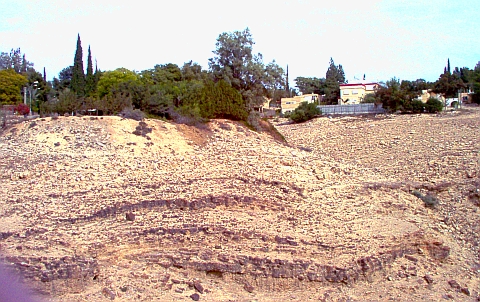
A Cartoon from Answers in Genesis, an organization whose members believe, like me, that Genesis 1 refers to a literal 6-day creation. Unlike me, however, they think the biblical authors described the universe in much the same way as modern science (as opposed to their literal belief in a 3-tiered 'universe').
Chris Heard at Higgaion has got wound up about Steven Pinker’s ridicule of the account of creation in Genesis 1. Steven Pinker, seeing things from a solely scientific point of view, criticises Genesis 1 for saying the world was created in six days and light was created before the sun. For Pinker, Genesis 1 contains “absurdities” in light of modern scientific knowledge. But for Chris Heard, these very absurdities show that Genesis 1 was not intended to be read as literal fact but as “non-literal” or “metaphorical” accounts.
It’s a common enough debate. And both sides are wrong.
Pinker and modern scientific critics are wrong when they do not take account of the fact that Genesis 1 is not only making mundane “how” statements, but also answering cosmological and divine “how” and “why” statements. That is, when scientists write off the whole text on scientific grounds, they can sometimes falsely reduce the biblical text to something that only deals with mundane “how” questions. This is obviously not the case with Genesis 1. Yet this is a comparatively minor mistake compared to the apologetic interpreters.
The metaphorical apologists will also be wrong if they simply choose to interpret Genesis 1 as “non-literal” or “metaphorical” — whenever a literal reading would demonstrate a biblical passage to be incorrect in light of modern science. If science shows that the “days” of Genesis 1 cannot literally be correct, the apologists will be wrong if they choose a non-literal interpretation merely as an apologetic ploy to save the text. There must be better grounds for interpreting either metaphorically or literally. But in the case of Genesis 1, the difficulty with a literal interpretation so often forces apologetic interpreters into choosing the metaphorical alternative, rather than considering the meaning of the text. The apologetic intepretation is motivated by the perceived need to “save” the biblical text.
Now, Chris Heard claims he has good grounds for a non-literal interpretation. His reasoning is that the absurdities we moderns see in Genesis 1 are so obviously absurd, that even ancient Judean authors and their audiences would have known they were absurd. Thus, we must conclude that Genesis 1 was always intended metaphorically:
“I seriously doubt that any ancient Judean of any period could fail to notice that, “absurdly,” the Genesis 1 story operates on a cycle of evening and morning for three days in the absence of sun and moon, which allow humans to measure days. In fact, the narrator even calls attention to this “absurdity” by specifying that sun and moon function as timekeepers … The ancient believers who created, edited, preserved, and transmitted knew very well that you can’t measure days without reference to the sun. They knew very well that Genesis 1 presented a schematic account of creation rather than an historical (much less scientific) one.”
– Chris Heard, ‘Absurdities as Genre Markers’
(I note in passing that a similar apologetic argument from “absurdity” is offered by certain New Testament scholars, who argue, for example, that Matthew’s account of zombie saints rising from the dead and wandering around Jerusalem is just so “absurd” that it must be true.)
The thing is, while these things are certainly absurd for me, for Chris Heard, and for quite a few other modern, academically minded folk, there was no such “absurdity” 2000+ years ago. The apologetic explanation is nothing more than a “just-so story” about perceived absurdity, lacking any serious attempt to study the ancient reception of Genesis 1. And when we do look at its ancient reception, we see that — far from being viewed as “absurd” and “metaphorical” — it was usually viewed as an oddity that had a miraculous but quite literal explanation. Sure, it wasn’t “history” or “science” in a modern, empirical understanding of those fields. But the apologetic alternatives which are offered (‘metaphor’ or ‘modern scientific textbook’) provide nothing more than a simplistic false dichotomy. In reality, the authors of Genesis 1 were just as interested in “how” questions as modern scientists, although they were also quite interested in questions about the “how” and “why” of cosmological and divine matters compared with their modern counterparts.
James Barr — who was much more knowledgeable than Steven Pinker concerning the Old Testament, and much less apologetic than the metaphor-apologists — comments:
“About the actual processes of the origin of the world as we know them, [the author of Genesis 1] knew, of course, nothing, and set against our knowledge of these processes his account is certainly ‘wrong’. Since, on the other hand, the processes and sequences which are known to us through modern science were certainly totally unknown to him, this ‘wrongness’ is quite irrelevant in our understanding the story.”
– James Barr, Fundamentalism. Philadelphia: Westminster Press, 1977: 41
Quite contrary to Chris Heard’s arguments, the ancient reception of Genesis 1 demonstrates that they usually took the first chapter of the Bible quite literally in its statement concerning the time of the creation of light — out of ignorance of any necessary causal connection between the sun and light on earth. Light, in the understanding of the ancient authors of Genesis 1, could just as easily be literally created before the sun as after it:
– A common interpretation of Genesis 1 was that God created “light” on Day 1 without revealing it yet. It was only revealed on Day 4. So Jubilees 2.2 explains that on Day 1 God prepared the light “in the knowledge of his heart”. The light was literally created in the divine realm, but was not literally set in place in the firmament. Likewise, 11QPsa (11Q Hymn to the Creator) explains that God literally divided light from darkness on Day 1, but that this was prepared “in the knowledge of his heart”.
– Utilising Psalm 104.2, others explained that the “light” of Day 1 literally came from God’s own glory or shekinah, literally distinguished from the light which came literally from the sun and moon on Day 4. So Genesis Rabba 3.4.
– b. Ḥagigah 12a makes the claim that the “light” of Day 1 was a miraculous light which would have allowed people to see from one end of the earth to another. After Adam’s fall, that light has been kept for the messianic age.
The preference for a “non-literal”, “metaphoric” interpretation of Genesis 1 is nothing more than a modernist attempt — in the light of modern science — to save the meaning of Genesis 1. This is still the case when the apologetic interpretation is misleadingly contrasted with the interpretation of Genesis 1 as “a scientific textbook”, as though that were the only alternative.
 Congratulations to Thomas L. Thompson, who turns 70 today (Jan 7, 2009). Since his landmark work on the non-historicity of the patriarchal narratives in Genesis — except for a short stint as a house-painter — Professor Thompson has been at the forefront of work on myth and (lack of) history in biblical narratives. His major works include The Historicity of the Patriarchal Narratives (1974), The Origin Tradition of Ancient Israel (1987), The Early History of the Israelite People (1992), The Bible in History: How Writers Create a Past (London, 1999) = The Myth of Ancient Israel (New York, 1999), and The Messiah Myth: The Near Eastern Roots of Jesus and David (2005).
Congratulations to Thomas L. Thompson, who turns 70 today (Jan 7, 2009). Since his landmark work on the non-historicity of the patriarchal narratives in Genesis — except for a short stint as a house-painter — Professor Thompson has been at the forefront of work on myth and (lack of) history in biblical narratives. His major works include The Historicity of the Patriarchal Narratives (1974), The Origin Tradition of Ancient Israel (1987), The Early History of the Israelite People (1992), The Bible in History: How Writers Create a Past (London, 1999) = The Myth of Ancient Israel (New York, 1999), and The Messiah Myth: The Near Eastern Roots of Jesus and David (2005).
 Leo takes apart
Leo takes apart I noticed this disturbing archaeological News on
I noticed this disturbing archaeological News on 




